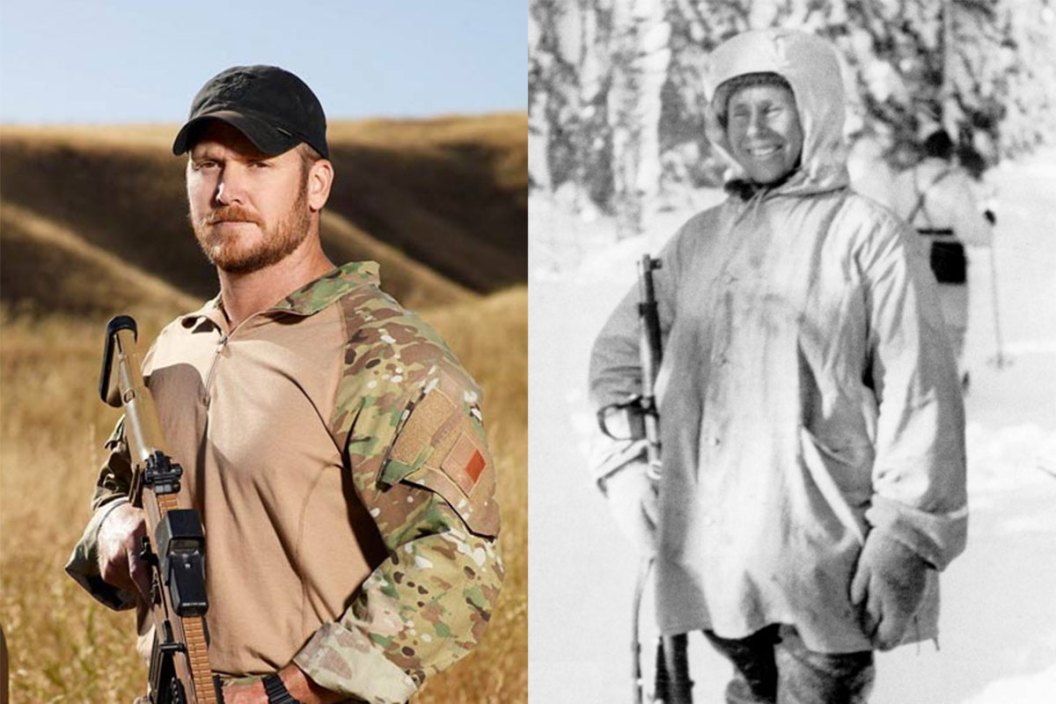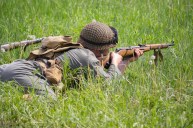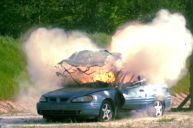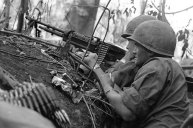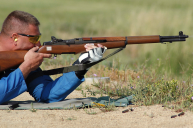These are considered some of the greatest military snipers who ever lived.
Throughout military history, snipers have played a key role in turning the tide in countless conflicts around the world. These men and women have extremely tough job. Often, they must make split-second decisions to take a shot that will save the lives of their fellow soldiers.
In many cases, snipers are the unsung heroes of war.
While most of us have heard of high-profile famous snipers like Chris Kyle, there are plenty of other men and women who famously served as snipers throughout history. Many of them have fascinating backstories of courage and sacrifice that deserve to be heard.
With that in mind, today we're recognizing six notable snipers. We're not just focusing on the deadliest snipers in history or the ones who made the longest shots. We're also going to tell you about some with amazing stories that served different armies in conflicts the world over. Because their stories deserve to be heard.
Chris Kyle, U.S. Navy: Served from 1999-2009
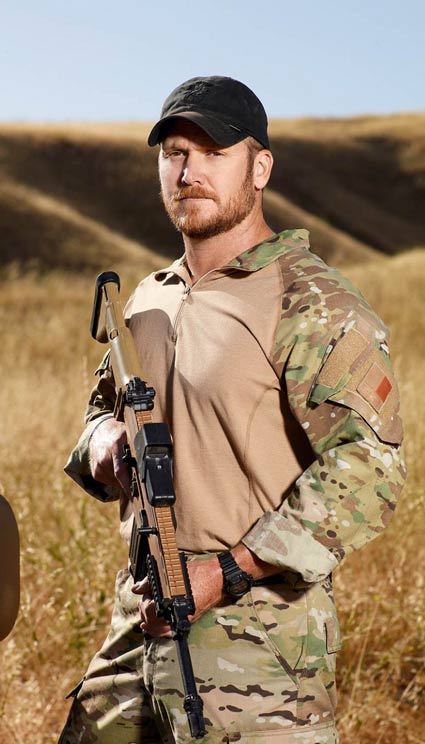
Wikimedia Commons: Mark Rovison
Chief Petty Officers Chris Kyle is now arguably the most famous U.S. Navy Seal in military history. A Texas native, Kyle learned to shoot from his father at a young age. He used those marksman skills to graduate with Navy Seal class 233 in March of 2001. He served four tours of duty in Iraq where he quickly earned the nicknames "The Legend" with his fellow soldiers and "The Devil of Ramadi" with Iraqi insurgents.
Accounts vary on just how many confirmed kills Kyle had during his service, but most sources cite at least 160. That would make him the most efficient sniper in U.S. military history. His longest shot, which he later described as "straight up luck" in his book, took out an insurgent at 2,100 yards during a battle in Sadr City in 2008. He used a McMillian TAC chambered in .338 Lupa Magnum to accomplish this incredible shot. Kyle was wounded twice in action. In 2009 he left the service to focus on his family. Over his 10-year career he earned a Silver Star for gallantry, a Navy and Marine Corps Achievement Medal and four Bronze Stars for Valor.
After his service in the Iraq War, Kyle wrote "American Sniper," an autobiography that became a best seller and was eventually made into a film by Clint Eastwood. Kyle also took an interest in helping his fellow veterans after his service and began working with other soldiers to help them adjust to life after the military.
Unfortunately, as most people already know, on February 2, 2013, Kyle and his friend Chad Littlefield were murdered in cold blood by a US Marine Corps veteran they had taken to a shooting range. Kyle's memorial service in Cowboys Stadium drew hundreds of people. He is buried in Austin where his grave now draws visitors every year. Kyle's widow Taya formed the Chris Kyle Frog Foundation to help military and first responders in Kyle's memory. Additionally, a statue of Kyle was later erected in his hometown of Odessa, Texas.
Carlos Hathcock, United States Marine Corp, Served from 1959-1979
Gunnery Sergeant Carlos Norman Hathcock's service in the Vietnam War is the stuff legends are made from. Hathcock's father fought in World War II and his stories inspired the young Carlos to join up with the Marine Corps at age 17. Hathcock's skills were already polished from hunting at an early age, but he quickly impressed everyone with his shooting prowess in competition.
In 1966, Hathcock was deployed to Vietnam. While he was originally sent to serve in the military police, he volunteered for sniper duty and quickly earned a reputation with both fellow soldiers and the Viet Cong and the People's Army of Vietnam (PAVN). The latter two groups called Hathcock "White feather" because of the sniper's signature feather in his hat. Officially, Hathcock's number of confirmed kills stands at 93, but it's estimated he may have had as many as 300 or 400 unconfirmed ones.
The Gunnery Sgt is also responsible for one of the longest kills in history. In February of 1967, Hathcock had a confirmed kill at a staggering 2,500 yards. The most amazing part about this feat was the fact that he accomplished it with a slightly modified M2 Browning machine gun chambered in .50 BMG!
Eventually, Hathcock's efficient shooting caused enough headaches for the PAVN to put a $30,000 bounty on the lethal sniper's head. It was never collected. In fact, Hathcock killed many of the enemy snipers who tried to collect. All while he kept taking out other notable enemy personnel.
Carlos was responsible for taking out a notorious sniper known as "The Cobra" who was responsible for killing Marines in and around Hill 55 near Da Nang. Hathcock took the Cobra out with a single shot that passed clear the other sniper's rifle scope. In the same area, Hathcock killed a notorious female sniper known as "Apache" who had tortured and killed U.S. prisoners of war in the past.
However, his biggest feat was a solo mission to eliminate a Vietnamese General. It took him four days and three nights to crawl nearly 1,500 yards and infiltrate the enemy camp. He took the general out with a single shot as he stepped out onto the porch of his hut. Hathcock's active service career ended in 1969 after an anti-tank mine disabled the armored personnel carrier Hathcock was riding in. Even while injured, White Feather furthered his legend. He saved seven marines from the burning vehicle. In the process, he suffered third-degree burns to large parts of his body, effectively ending his service. He returned to the United States and established the Marine Corps Scout Sniper School in Virginia to pass his skills on to others. Unfortunately, the injuries he suffered in the war led to a slew of health issues that later led to his early death in 1999 at the age of 56. When all was said and done, the sniper had earned a Silver Star, a Navy Commendation Medal, a Purple Heart and several other awards for good conduct, service and gallantry. The Marine Corps re-named a range in his honor.
Simo Häyhä, Finnish Army, Served 1925-1940
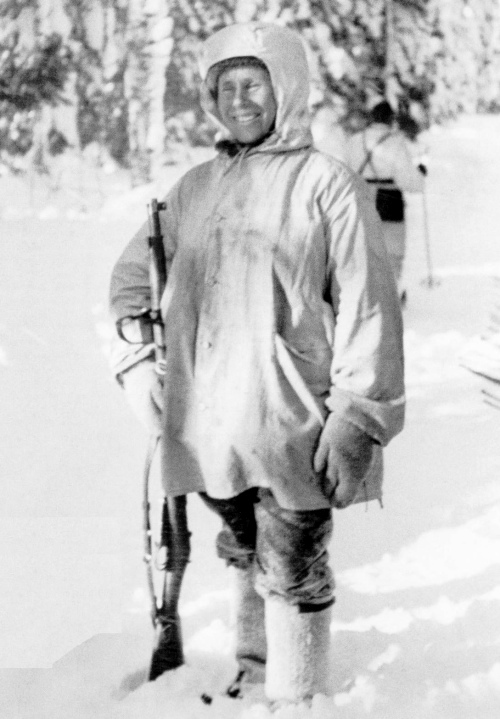
Wikimedia Commons: Finnish Military Archives
This Corporal and Second Lieutenant Finnish sniper terrorized the Red Army during the Winter War, which was a conflict between the former Soviet Union and Finland. It lasted roughly a year from November of 1939 to March of 1940. Simo, a simple 20-year-old farmer and hunter joined up with the Finnish Army to serve his country and consequently stepped into military legend.
The humble Simo's shooting skills were nearly unmatched in both competition and on the battlefield. Over the course of the conflict, Simo was responsible for hundreds of kills both with M/28-30 bolt-action rifle and a submachine gun. Some believe he may be responsible for more sniper kills than any other soldier in the history of the world. No small accomplishment.
The number of Red Army troops downed by Häyhä' is only partially documented. The exact number is unknown. His superior officers have credited him with anywhere from 250-540 kills via sniper rifle and an additional 200 with a submachine gun. After his death, Simo's diary was discovered. In it, he reveals he believes his total number of kills, which he called "his sin list," to be close to 500.
His actions on the battlefield earned him the nickname "The White Death." Things get even crazier when you start reading about HOW Simo worked as a sniper. He reportedly preferred iron sights only and while concealed in the snow, would put additional snow in his mouth to keep his breath from revealing his position. Simo's feats on the battlefield are even more amazing when you consider that the Winter War was so short. His service came to an end roughly a week before the war ended after Simo was shot in the jaw. The wound was so severe that newspapers declared he was killed in action.
The sharpshooter made a full recovery after the war despite losing much of his left cheek. He lived to the ripe old age of 96, although he never talked much publicly about his service. Shortly before his death he remarked that he "only did what he was told to do."
Chuck Mawhinney, United States Marine Corps, Served 1967-1970
By the numbers, Charles Benjamin Mawhinney is considered the most successful sniper the U.S. Marine Corps ever produced. Like many of the others on this list, Mawhinney was an avid hunter that later used his shooting skills on the battlefield. After graduating Scout Sniper School at California's Camp Pendleton, Mawhinney was sent to Vietnam in 1968.
The Sergeant spent 16 months total in Vietnam and managed to rack up 103 confirmed kills. His unconfirmed kill count includes 216 more. Mawhinney served as a scout sniper and used an M 40 bolt-action rifle chambered in .308. Among his more incredible battlefield accomplishments was when he took out 16 North Vietnamese army soldiers in 30 seconds on Valentine's Day 1969 with an M-14 rifle. All with headshots. You can hear him talk about that experience in the video above.
Eventually Mawhinney returned to Camp Pendleton after being declared combat fatigued. We may have never known about Mawhinney's exploits in Vietnam had another Marine sniper discussed Chuck in his book. Mawhinney didn't discuss the war for over 20 years. Since then, he has spoken about his service many times. He has stated his only regret is the target who got away.
"I can't help thinking about how many people that he may have killed later, how many of my friends, how many Marines," Mawhinney said. "He messed up and he deserved to die. That still bothers me."
Today one of Mawhinney's rifles is on prominent display at the National Museum of the Marine Crops in Virginia. Chuck sought out a career with the U.S. Forest Service after the war. Today he lives in Oregon, but still makes public speaking engagements and TV appearances from time to time. There has also been a re-issue of the M 40 rifle in his honor. Also, the top graduate for the Camp Pendleton sniper school receives a custom knife from Strider Knives bearing Mawhinney's signature.
Lyudmila Pavlichenko, Red Army, Soviet Union, Served 1941-1953

Wikimedia Commons: ??????? ????????? ????????
Some might be surprised to learn one of the most famous Soviet snipers of World War II was a woman. The Army Lieutenant and Soviet Navy Major was a skilled athlete from an early age, but she was best at shooting. In June of 1941, she was studying at University to be a teacher when the Nazis invaded the Soviet Union. Pavlichenko dropped everything to sign up for the army to fight the German invasion. She was put to duty in infantry after refusing to accept a role as a nurse.
Pavlichenko's shooting skills quickly earned her a sniper role in the army, but because of a weapons shortage, she didn't have a firearm of her own at first. That was, until August of 1941 when a wounded soldier gave Pavlichenko his Mosin Nagant. It ended up being a pivotal moment in the young woman's military career as she recorded the first two confirmed kills. By the time all was said and done, she had 309 confirmed kills, making her the deadliest female Soviet sniper in history. One of the sadder aspects of Pavlichenko's story is the fact that she married another sniper, Alexei Kitsenko, while the war was still raging. The marriage was tragically short-lived as Kitsenko was killed by mortar fire a couple months later.
Pavlichenko continued the fight however, and even trained more snipers during her service. It didn't take long for her to earn the nickname "Lady Death." Eventually, in June of 1942, she was severely injured by a mortar and spent more than a month in the hospital. Soviet officials decided not to send her back to the front lines. Instead, they felt she was more valuable for publicity in the war effort. She was subsequently sent on tours to the United States and Canada. Pavlichenko even visited the White House and met with President and First Lady Franklin and Eleanor Roosevelt. Eleanor later re-visited Pavlichenko years later in 1957.
Sadly, while Pavlichenko finished her education after the war, it is believed she also suffered from severe PTSD. She died in 1974 at the age of 58, her death likely brought on sooner by struggles with alcohol. Pavlichenko received the "Hero of the Soviet Union" award for her service.
Adelbert Waldron, U.S. Army/U.S. Navy, Served 1953-1965 (Navy) 1968-1970 (Army)
There isn't a whole lot of information out there about Staff Sergeant Adelbert Waldron. Much of his service history is shrouded in mystery. He first served in the Navy during the Korean War. He was discharged from the Navy in 1965 and enlisted in the Army three years later. He was sent to Vietnam in 1968 where he attended a sniper training program.
Shortly after that, Waldron became a member of the 9th Infantry Division where he was deployed to the Mekong Delta. He utilized the XM21 sniper rifle to make 109 confirmed kills during only eight months of deployment. One of those kills was allegedly a 900-yard shot from a moving boat. Another story says Waldron held off multiple Viet Cong soldiers single-handedly for hours by constantly changing positions.
In 1969, Waldron returned to the states and spent some time training more snipers at Fort Benning in Georgia before he was discharged from the Army in 1970. He died in 1995 at the age of 62 and is buried in Riverside National Cemetery in California. Waldron is still arguably one of the most decorated snipers in U.S. Military history. He earned three Bronze Stars, two Distinguished Service Crosses, a Silver Star and a Presidential Unit Citation, which is awarded for extreme heroism and gallantry.
For shooting accessories, visit walmart.com.
For more outdoor content from Travis Smola, be sure to follow him on Twitter and check out his YouTube channel.
NEXT: TOP 5 MILITARY SURPLUS DEER RIFLES
WATCH
https://rumble.com/embed/u7gve.v3v8nl/
